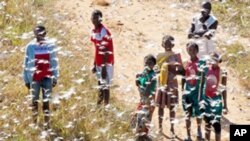Madagascar is again facing a locust threat. The U.N. Food and Agriculture Organization says there’s another build-up of locusts in southwestern Madagascar that could become a “plague” if no action is taken. If unchecked, the FAO says, the livelihoods of 13 million people could be affected.
It’s the same area of the country where operations were conducted from last October through April to control the insects. Some 200 thousand infested hectares were sprayed.
Southwest
“The current situation is very serious because it’s what we call an upsurge. The locust infestations are still contained in the southwestern part of Madagascar. [It was the biggest] success of all operations we carried out during the locust campaign [of] 2010 / 2011. But there is still a high risk to have a worse situation during the next rainy season,” said FAO locust officer Annie Monard.
The next rainy season begins in October.
“It’s what we call the outbreak area of the Malagasy Migratory Locust,” she said. “And it’s from this area that the swarms can be produced and can invade the northwestern, the northern part of Madagascar.”
In the most recent campaign, enough hopper bands and swarms were killed to keep the situation under control. Hoppers are young, wingless locusts. But, the threat was not eradicated.
“If I compare with last year at this period,” she said, “there were already at least 50 swarms, which had invaded the western part of Madagascar.”
Why wait until October?
Although there are growing numbers of locusts, this is not the best time of year to take the offensive against them.
Monard said, “Winter is starting in Madagascar. It will be the dry and cool season, during which the population, which are adults, are very mobile. They are not a good target for control operations. So now what has to be done is to prepare.”
When the operations do begin, a number of pesticides will be used. For example, conventional pesticides will be used to kill adult locusts outright.
“We use insect growth regulators to combat hoppers,” she said, “and we use biopesticides.”
Biopesticides are used in environmentally sensitive areas, but they are more expensive than conventional pesticides. The locust control operation is expected to cost $7.6 million and continue through May 2012.







